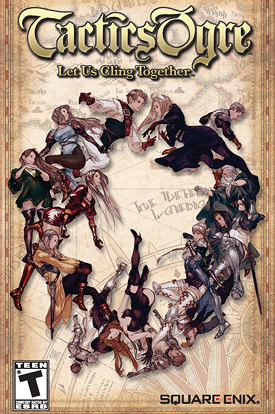Opulently Obfuscating
Tactics Ogre: Let Us Cling Together takes an outmoded, but influential, tactical RPG and overhauls it almost completely, in the process making it one of the premier RPGs on the PSP. Originally developed for the Super Famicom in 1995 by Quest, the now-defunct studio of lauded director Yasumi Matsuno, Tactics Ogre did much to establish standards in the turn-based strategy genre, only for those ideas to result in its more popular spiritual successor, Final Fantasy Tactics, a few years later. However, this modern revamp of Tactics Ogre – offering new 3D battlefields, arranged music, an exemplary localization, and across-the-board streamlining – is brimming with new life (and a couple old annoyances) yet retains the many intricacies that define its legacy.
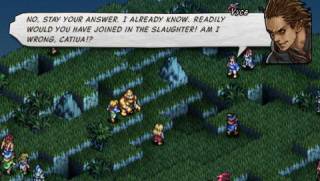
Serving as centerpiece to the game is Tactics Ogre’s borderline ridiculous story, though it’s ridiculous for its density rather than being over-the-top crazy. It also pulls no punches and takes itself very seriously, which can often fall flat but here the political and military drama provides an appropriately epic vibe to what is essentially a war game. Set on a medieval-styled island called Valeria, a struggle erupts when its ruler, the Dynast-King Dorgalua, dies without a successor, leaving a vacuum of power between vying factions that bathes the island in blood. Main character Denam Pavel, his sister Catiua, and comrade Vyce Bozeck have the unfortunate distinction of being part of Valeria’s oppressed minority, and subsequently you’re put in control with them vowing to resist against the abusive tyrants. The plot only escalates from there, immediately throwing name after name at you, from Galgastani to Walister to Xenobia. It’s totally confusing, but if you’re willing to pay attention, and very close attention mind you, the story and relationships will pan out satisfactorily. Undoubtedly adding the story’s effectiveness is the updated localization, an extremely readable effort full of quasi Middle English that’s on par with other praised Matsuno works like Vagrant Story, Final Fantasy XII, and the Final Fantasy Tactics PSP port.
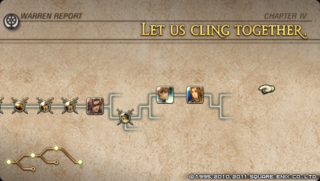
Tactics Ogre’s story will also force you to make gripping, impactful choices at certain points, leading to a branching series of paths and different endings. However, it’s very easy to keep track of where you stand in the story, as a timeline is always available for viewing in the Warren Report, the game’s invaluable compendium of knowledge that also keeps track of your battle statistics, characters you’ve met, cutscenes you’ve viewed, and music, though the lack of a glossary of terms is unfortunate and having one might have softened the initial barrage of story-related nomenclature. But that’s not all the Warren Report can offer: when you complete the game, it unlocks the “World” option on the event timeline which allows you to dial back time to certain key “anchor points” throughout the game with all earned characters and equipment intact, conveniently negating the need to restart the game entirely. It’s an easy and welcome way to see the parts of the game you may have missed, and knowing you won’t have to burden yourself with starting over encourages repeated play.
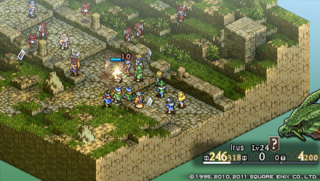
Of course, the battlefield is where you’ll be spending the majority of your time in Valeria, and if you’ve played a Tactics game of any name before, you probably have an idea of how it plays: maps made of geometric tiles of differing heights, squat units that are constantly marching in place, stats seemingly in every corner of every menu, tons of thwacking enemies square in the back, and of course, it’s all turn-based. Once you’re settled into battle, you’ll command 6 to 12 of your own units against an equal or larger enemy force, with the goal of routing the whole opposing squad or merely eliminating the enemy leader. It’s a bit annoying that you can’t see what enemies are on the field before you commit your team to battle, as some, such as undead, require specific skills to dispatch properly. Japanese tactical RPGs are also no strangers to chugging along at their own pace, your patience be damned, but Tactics Ogre does everything in its power to expunge the cruft of the battle process by speeding up movement and attack animations for characters on both sides of the conflict, ultimately giving you more time to control your own units and plan their actions accordingly. This hastening is welcome as the average battle will still take anywhere from 10 to 30 minutes to complete.
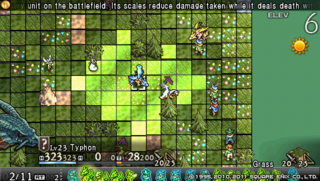
Tactics Ogre’s colorful battlefields are now in 3D, though the isometric ¾ perspective might still give the illusion of two dimensions. For some reason, the game defaults to a zoomed in view that makes everything appear blurry, but you can quickly zoom out to a more native resolution that looks much crisper. The battlefield can also be tilted to a bird’s eye view to get a better perspective on where units are placed, in case the environment obscures them – and it will. It might have seemed more impressive to give a full 360 degree rotation of the battlefield, but seeing as the original 2D battlefields were designed to be viewed from one angle, the bird’s eye view ends up being a quick and elegant solution. The short character sprites, somewhat resembling powerwalking fetuses, still retain their classic charm, but the real star of the visual presentation is the gorgeous new character art by original artist Akihiko Yoshida, though it’s a pity the art is often relegated to small portraits. The game also has a new screenshot feature that allows you to quickly snap a particularly memorable piece of dialogue or other moments for sharing elsewhere.
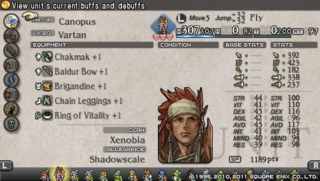
The designs of Tactics Ogre’s battlefields have enough variance to keep the simple terms of victory from becoming tedious, often putting the enemy at some kind of tactical advantage that will make you feel proud when you plan ahead and succeed. When the game is at its best, each of your units’ turns will require you to stop and pore over the numbers and statistics of each possible action, making this not a game for the impatient. However, there are still a great number of battles that are more straightforward, close-range skirmishes which can be brute-forced with the same dependable units like knights and archers rather than requiring any real strategy. Despite this, it’s still incredibly satisfying to go on a murderous rampage and whittle the enemy down one-by-one thanks to the rewards you get for kills, like equipment and stat-boosting cards.
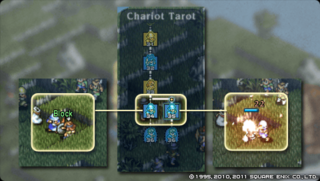
One big, positive change to the game is how it handles player deaths. In the original version, when a character’s HP was depleted in the battle they died for real right then and there, with little exception. This remake, however, is a lot less punishing: unconscious units will remain down for three turns until they become incapacitated, just as in Final Fantasy Tactics, and on top of that, each unit has three “lives” with which they expend upon an incapacitation. In practice, the latter gift is seemingly too generous, as if you can’t revive a unit within 3 turns of the battle, then the problem probably lies more in your battle tactics. On top of that, if a battle you were wresting control of starts to go south due to ill luck or otherwise, you no longer have to accept defeat and restart, as the game introduces the useful, but entirely optional, Chariot system. The Chariot allows you to rewind time in the battle up to 50 unit turns, which is ample time to try a different, hopefully more effective strategy. However, the game will keep track of the effectiveness and probabilities of your past actions, so if you do the same thing as before you’ll just get the same failing result time and time again, but forcing you to think outside the box is a good thing. Overall, these changes nearly eliminate the cheapness factor of the difficulty, keeping the challenges mostly ones of strategy.
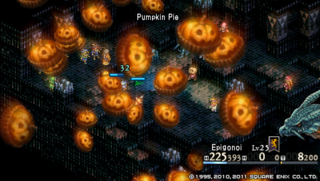
Still, even with these changes, certain encounters might give you reason to toss your PSP off a cliff. There are more than a handful of storyline battles that force you to protect an AI-controlled character from a swath of baddies. This wouldn’t be so bad except that, for whatever reason, the AI allies will almost always charge head-first into the enemy line, getting outflanked and killed faster than you might even be able to reach it. These AI babysitting missions can require some real trickery to solve and are almost always exercises in frustration, but at least they represent a fractional minority of the game’s total battles.
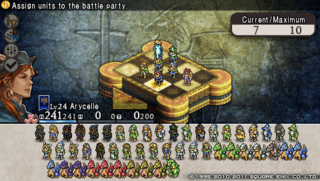
While battling is the crux of the game, what really gives Tactics Ogre the complexity to last its 50-60 hour average duration is its intricate unit micromanagement. The most important of your options are the character classes and counting all the different monster types, there are a couple dozen classes to choose from. Some are more useful than others (and some more broken than others, i.e., Archers), but all are subject to another one of the remake’s sweeping changes: units no longer level up individually, but instead level up the class itself, for all units to share. On the whole, this is a great change since it allows you to make more on-the-fly adjustments regarding your party setup and strategy. It does come with some caveats, especially that new classes will always start pitifully underleveled at 1, making them nigh-useless enemy fodder, and worse, may require grinding to fix.
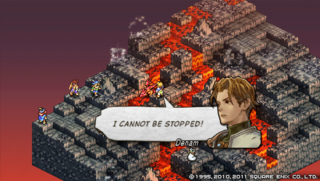
The class streamlining might appear to steal a bit of individuality away from the characters in your army, but that’s definitely not the case as each class has plenty of unique skills, from Knights’ defensive formations to Clerics’ MP regenerating boosts, and most classes will learn deadly and invaluable finishing moves unique to their weapon specialty. And you’ll quickly find yourself with more skills than you can actually use, including a whole range of stat-augmenting options, leaving plenty of room for individualized builds. But where the game really goes off the deep end is with the Chaos Frame, an opaque meter of what the other factions and races in the game think of you. While this sounds important, it will really only affect the recruitment of a few characters over the course of a normal playthrough, so it’s the kind of thing that will matter mostly to completionist types – and will probably drive them crazy in the process.
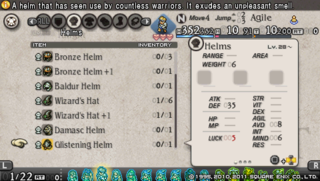
Unfortunately, a major pock mark on the game’s interface is the obtuse menu design. To do something as simple as changing a unit’s weapon will have you sifting through many layers of screens, and even when you are dozens of hours into the game you could find yourself selecting the wrong option. They aren’t broken, but the menus come off as very inelegant and cumbersome and it’s a shame the game couldn’t provide a more intuitive way of handling basic and oft-repeated actions like selecting new skills and equipment.
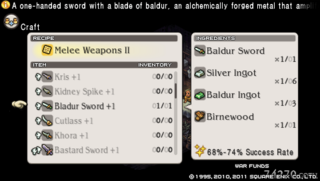
One other new addition is an item crafting system, which allows you to make upgraded versions of most weapons and armor using various resources, though sadly it also falls victim to the clunky menu design. Crafting require ores and ingots you will need multiples of to make items worth a damn, but those ingredients are scattered across different menus and on top of that, only one item can be made at a time. To add insult to injury, some craftings are not 100% guaranteed and upon failure you lose all the items in the process. This just encourages you to save before you craft, which is more of a hassle than a solution. Despite how this sounds, the equipment you can make is significantly better than what’s purchasable, so players dedicated enough to look past the inconveniences will find themselves addicted to the rewards.
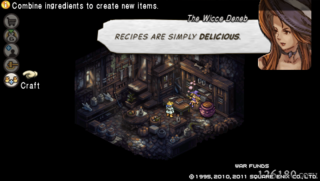
It’s also worth noting that the game’s audio is superb. The world-class bombastic and energetic score by Hitoshi Sakimoto and Masaharu Iwata is arranged just about perfectly, taking the original 16-bit sounds and polishing them to modern levels of quality orchestral synth, with a few select tracks played by an actual orchestra. Though both composers have settled into their own stylistic niches at this point, this 15-year-old soundtrack still sounds fresh and is every bit as good as their best work.
In many ways, this remake of Tactics Ogre can be seen as the sequel-that-never-was to Final Fantasy Tactics. The similar thematics, music, and customization will appeal to fans of that seminal title in ways that more lightweight fare like Final Fantasy Tactics Advance and A2 could not, though it’s a shame the interface and occasional frustrating AI battle blemish the overall package. But the enhancements gained from the streamlining definitely outweigh those annoyances and solidify this PSP remake as the best way to ever play Tactics Ogre: Let Us Cling Together.
